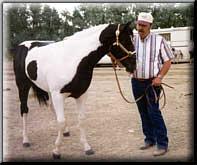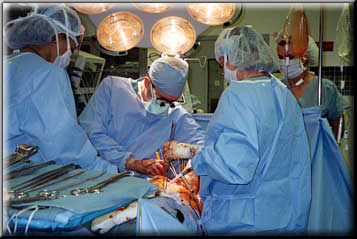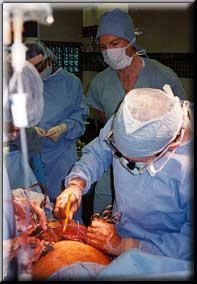"Get Back On That Horse."
Yvonne Thorp describes her 53 year old husband Don as a "workaholic." It sounds bad until you hear what kind of work Don enjoys. Don works his typical 40 to 50 hour week as the manager of an Idaho Falls area public transportation system -- a company whose ridership under Don's direction rocketed from 40,000 in 1985 to over 300,000 in 1999. In his "spare time", Don runs a small company that breeds quality horses on a 33 acre ranch he owns near Ririe, Idaho.
Don Thorp approaches both jobs with equal passion. He works hard and he plays hard. "I never was one to sit around," he mused, as if the thought of doing nothing ever even occurred to him. Don served in the U.S. Navy from 1964 to 1985 and learned firsthand that every difficult challenge presented an opportunity to succeed where others might fail. When he retired from the Navy, he intended to go back to college full-time. Instead, he accepted a job at a nearly bankrupt bus company that was loaded down with debt and went to night school to earn his college degree, while also caring for three children.
The hard work and can-do spirit paid off. Don received his degree much sooner than he thought and the transit company expanded from seven buses and nine employees in 1985 to 34 buses and 60 employees in 1999. More importantly, Don felt the satisfaction of knowing he had helped build something valuable for people who needed help. Brad Brady, who is the Chairman on the Board for the bus system, calls Don "one of the hardest working and compassionate individuals I have ever known." Mr. Brady continues:
We were very fortunate in finding Mr. Thorp to manage the day-to-day operations of the bus system. Whenever there was a problem with a shortage of drivers, without a second thought, Don would be behind the wheel himself driving until 8:00 p.m. if necessary. If we needed to pick up new buses in places like Arizona and Michigan, Don always went personally to make sure they arrived in good shape. Mr. Thorp has worked many twelve hour days, and I've never received a single complaint.
The entire Snake River Valley owes Mr. Thorp their gratitude for his tireless efforts to ensure transportation to the elderly, disabled and to the general public. Many of these people who could not afford their own transportation would be virtual prisoners in their own homes. Due to Don's efforts, our clients now have the freedom to go shopping, to the doctor and the grocery store.
When Don is not personally driving disabled children to school or elderly tourists to places like Missoula, Montana, or Jackson, Wyoming, Don devotes his time to his other children -- his 22 horses. I asked this bear of a man why he so enjoyed getting up at 5:00 a.m. on Saturday and Sunday morning to tend to a bunch of horses. "It's certainly not the money. We sell a few, but it's like taking care of pets. Every horse has his own personality. We play with them, talk to them, help them when they're sick -- we just love them."

SYMPTOMS BEGIN IN 1998
Don began feeling unusually tired in June of 1998. He developed a persistent dry cough. He sought attention from his family doctor who predictably prescribed anti-biotics and Robitussin. By November, the symptoms worsened. He was having right-sided chest pain as well. He began having night sweats. He was feeling nauseous and began vomiting. He went back to his local doctor who took a closer look. He ordered a CT scan which showed "enlarged lymph nodes", but in the end concluded that Mr. Thorp had suffered a heart attack.
Heart attack? Don Thorp is diabetic and as such knew his body like a Swiss watchmaker knows watches. Don figured it was time for a new doctor. He wanted a doctor who would look far and wide first before jumping to conclusions. Don met with a pulmonary doctor who suggested that cancer was a possibility. When Don and his wife Yvonne heard the "cancer" word they decided it was time to take action. They drove to Salt Lake City and met with Dr. Stringham, a thoracic surgeon, who agreed to perform a diagnostic thoracoscopy and possible thoracotomy if indeed any tumor was found.
DOCTOR LOOKS AT FILMS: "Did You Work With Asbestos?"
Prior to the surgery, Dr. Stringham reviewed films and asked Don point blank whether he worked with asbestos. Don never worked with asbestos occupationally. However, he served in the Navy from 1964 to 1985 and spent countless hours below deck on carriers, cruisers and destroyers during routine maintenance and overhauls. Dr. Stringham noted that the scar tissue on Don's lung linings was caused by asbestos.
Dr. Stringham performed the thoracoscopy on December 8, 1999. While Don was in the recovery room, Dr. Stringham advised Yvonne that he had found tumor on the chest wall. When Don woke up, he could tell by Yvonne's expression that the news was not good. "I have it don't I?" he asked, hoping against hope that this was simply a bad dream. Don was hospitalized for three days. During the procedure, Dr. Stringham harvested tissue samples and lymph nodes from the chest cavity and sent them off to the pathologist. A week later, the pathologists confirmed the diagnosis of malignant pleural mesothelioma, biphasic type.
LOCAL DOCTOR LUKEWARD ON SURGERY, DON'S FAMILY SEARCHES THE NET
Don had never heard of "mesothelioma." His sister-in-law, however, was a nurse and she began researching the Internet for answers. Don spoke to Dr. Stringham about his options. The surgeon advised that he could indeed perform an extra-pleural pneumonectomy (EPP), but his tone suggested that it was futile. "My doctor said it would be painful and would only prolong my life by a few months." After hearing nothing but grim news from the Salt Lake surgeon, Don wished he had never asked.
Don found out about Dr. Harvey Pass (Detroit), Dr. Robert Cameron (UCLA) and Dr. Eric Vallieres (Seattle) and contacted all three. He chose to consult with Dr. Cameron, mainly because UCLA was closer to his home in Idaho Falls. In a matter of days, on a Friday, Don and Yvonne found themselves face-to-face with Dr. Cameron. Dr. Cameron performed a complete physical and ordered another CT scan of the chest and the abdomen. The earlier CT scan showed diffuse pleural thickening, and, according to Dr. Cameron, a surprisingly minimal amount of disease, despite the long history of symptoms. The new chest CT confirmed the presence of fluid and/or tumor but could not illuminate whether lymph nodes were involved. The abdominal CT, thankfully, was clear.
DR. CAMERON SCHEDULES FAST-TRACK SURGERY

Dr. Cameron set the surgery four days later on Tuesday, January 25th. Dr. Cameron explained that he could not "cure" Don's cancer. Dr. Cameron's theory is that every day a mesothelioma patient lives the hope remains that a cure, or at least a meaningful therapy, can be found and administered. Dr. Cameron planned on sparing the lung and stripping off as much tumor as he could see.
Going in, the evidence suggested to Dr. Cameron that the tumor was minimal. However, upon opening the chest cavity, Dr. Cameron found more extensive disease than he anticipated. For the next eight and one-half hours, Dr. Cameron and his team painstakingly scraped, cut and burned the visible tumor off the base and apex of Don's right lung, as well as the tumor encroaching on the heart, phrenic nerve and diaphragm. To reach into the chest cavity and get at the tumor, Dr. Cameron removed the sixth and tenth ribs.
Some people refer to the pleurectomy as a "pleural peel." This is a misnomer. This is not like peeling a banana. The tumor aggressively adheres to the chest wall, lung, diaphragm and other organs. For most of the procedure, Dr. Cameron literally with one hand held back first a thick flap of bloody tumor from the chest wall, then the diaphragm and eventually the lung itself, while with the other hand he "electrocauterized" or burned the tumor away from the "good" organs.
ATTENTIONS TO DETAIL
The attention to detail was simply astonishing. Nothing was taken for granted. Dr. Cameron took no breaks, never asked for a sip of water, and never sat down. There are two pleural membranes: the visceral and parietal pleuras. The visceral pleura covers the lung itself and enters into the interlobar fissures. The parietal pleura is on the outside and backs up against the chest wall. The parietal pleura in Don's chest was obliterated by tumor. But surprisingly the visceral pleura was largely intact and void of tumor. Dr. Cameron tediously spent hours dissecting tumor that seeped deep down in the interlobar fissures, while sparing the lung itself.

Don remained hospitalized for the next six days. He described the experience as like "getting hit by a Mack truck." He was disoriented from the pain medication, which also caused him to be constipated. As a diabetic, Don can tell when his blood sugar is low. Don recalls that in the ICU within an hour of gaining consciousness he knew that he required a transfusion. The ICU nurses, however, attributed his chest pain to "a mild heart attack," which Don in his weakened state firmly rejected; the pain did not radiate down into his arm and his post-operative EKG and chest film were both normal. Due to a mix-up with (or misinterpretation of) the consent forms, Don waited longer than he wanted or should have to receive his transfusion. Don's only complaint was the interminable delay in getting the transfusion and the attendant stress from feeling ignored by the ICU nurses.
"We Have Nothing But Praise for Dr. Cameron"
Dr. Cameron met with Yvonne and the five other family members in the waiting room at about 9:00 p.m. He reported that he removed all the visible tumor without complications. "We have nothing but praise for Dr. Cameron," glowed Yvonne. "He's the finest of the finest. The hospital floor staff was great, too. We believe that our prayers have been answered."
The plan now is for radiation treatment. Dr. Cameron is working with Don's oncologists to arrange for radiation of the lower mediastinum, diaphragm and chest wall. Don recently visited with Dr. Cameron who was pleased with Don's post-operative condition. Dr. Cameron has arranged for Don to receive adjuvant radiation therapy with a doctor in Twin Falls, which is about 135 miles from Idaho Falls (but alot closer than Los Angeles).
DON TO UNCLE SAM: "We served you, now please serve us."
Don Thorp has the right stuff to "get back up on that horse." He intends to build the horse arena on his ranch that he's always dreamed about. Don is no stranger to adversity and accepts that life is not always fair. What he cannot accept, however, are the circumstances which are responsible for his predicament. He knows that his experience in the U.S. Navy for over 20 years taught him to push himself and do more. He has fond memories of serving under Admiral Elmo Zumwalt (who recently died from mesothelioma) during the Vietnam War. Don writes:
The Admiral was a sailor's sailor, he led by example, fairness and compassion. He provided the example that all aspiring naval personnel trust, follow and admire. He inspired me to become all I could be, rising through the ranks to become a commissioned officer. The Admiral carved his place in history with his military record and by fighting for Agent Orange victims. I only hope now that the name of Admiral Elmo Zumwalt, Jr. will lay side by side with the mesothelioma victims to open the eyes of those who can make a difference in our lives.
I served my Country proudly for 22 years. It is difficult for me to accept that my Country has not solved the mesothelioma menace, a war-related disease that has taken the lives of too many veterans. We served with pride, it's about time our country served us. Please solve the problem and eradicate mesothelioma soon.
Ride on, Brother.
*** POSTED FEBRUARY 25, 2000 ***
An Update -- 1/29/01
When we spoke to Don on January 29, he was preparing to travel to Los Angeles for his 3 month checkup with Dr. Cameron. The checkup includes several tests, including blood work and a CT scan. We will post the results of Don's visit when he returns.
An Update -- 3/18/02
Mesothelioma remains the constant focal point for Don. The ibuprofen and hydrocodone he takes sometimes cannot manage his pain. His last chest film with Dr. Cameron at UCLA in early February showed a spot on his lung, and Don hopes that the spot does not evidence a site of new tumor growth. In an effort to cleanse his lungs, he sees a naturopath -- a trained specialist that operates on the belief in the body's ability to heal itself given certain environmental conditions such as diet, light, water and herbal supplements -- and he and Dr. Cameron have been battling hospitals to get him into a treatment program with interferon. Don knows that the hope for possible survival lies in these treatments, and he's not about to give up. He visited the VA Hospital on February 21 to see if he can begin treatment with interferon, and he will know the answer by March 21. We will keep you posted on the progress of this positive and enduring man.
An Update -- 8/7/02
Don is still trying to get set up with interferon treatments through the VA. The doctors at the Salt Lake City VA have told him there was no way to gauge the effectiveness of such treatments and felt there was no concrete evidence of its effectiveness. He is hoping that his request to have the interferon administered through the VA in Los Angeles, California, where Dr. Robert Cameron serves as one of their physicians. On the homefront, he continues to experience a lot of pain and has his ups and downs, but he keeps himself busy with his equestrian business. Don's motto "Knuckle up and take care of business." He recently opened an indoor horse arena which serves as a venue for shows, sales and open-riding during the winter months. He is in the process of setting up a similar venue for the summer. We wish Don fair winds as he rides on the VA's sea of bureaucracy.
Mr. Don Thorp passed away on August 16, 2003


